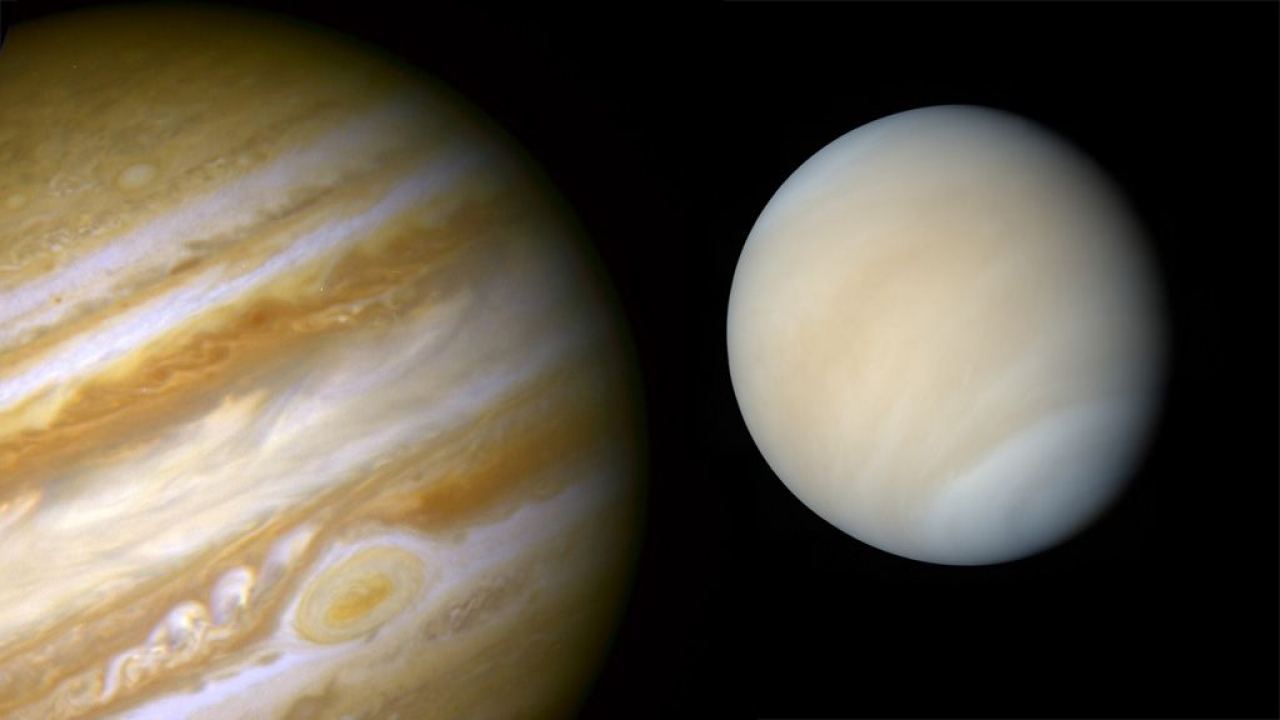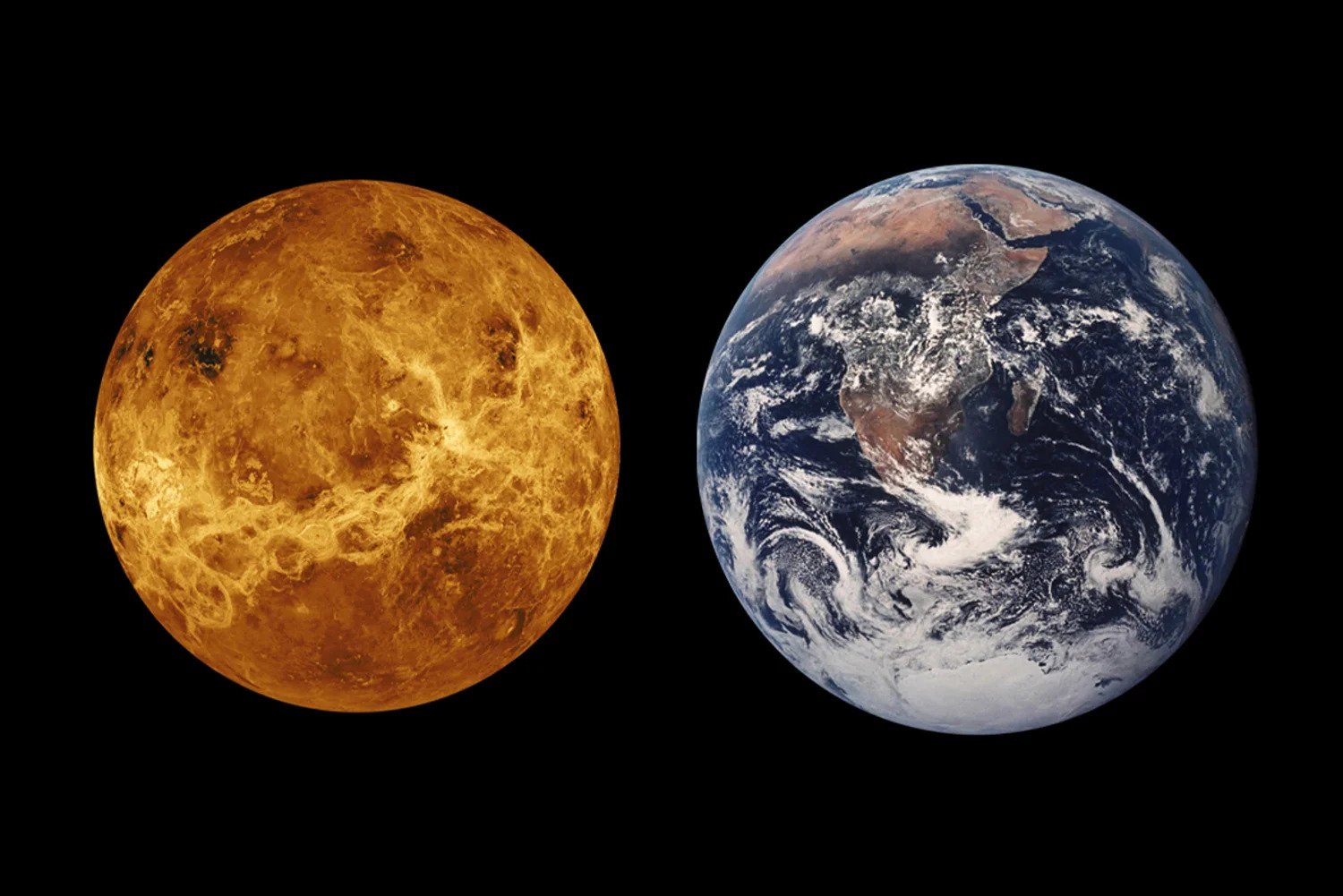Home>Gardening News and Trends>What Causes The Greenhouse Effect On Venus


Gardening News and Trends
What Causes The Greenhouse Effect On Venus
Modified: January 22, 2024
Discover the Latest News on What Causes the Greenhouse Effect on Venus. Explore the fascinating factors behind Venus' extreme greenhouse effect and its implications for our understanding of planetary climate.
(Many of the links in this article redirect to a specific reviewed product. Your purchase of these products through affiliate links helps to generate commission for Chicagolandgardening.com, at no extra cost. Learn more)
Table of Contents
Introduction
Welcome to the mysterious world of Venus, a planet known for its extreme greenhouse effect. Just like Earth, Venus has an atmosphere composed of various gases that surround its surface. However, the greenhouse effect on Venus is unmatched in its intensity and impact. In this article, we will explore the causes and consequences of the greenhouse effect on the neighboring planet.
The greenhouse effect is a natural process that occurs on many planets, including Earth. It is essential for regulating the temperature of a planet and making it habitable. However, when this effect becomes excessive, it can lead to drastic changes in the climate and surface conditions. The greenhouse effect occurs when certain gases in the atmosphere trap heat from the sun, preventing it from escaping back into space. This leads to an increase in temperature, both in the atmosphere and on the planet’s surface.
When we compare Venus and Earth, we can see some similarities but also striking differences. Venus is often referred to as Earth’s twin due to its similar size and composition. However, the conditions on Venus are vastly different from our home planet. While Venus is the hottest planet in our solar system, with surface temperatures reaching an astonishing 900 degrees Fahrenheit (475 degrees Celsius), Earth remains a comfortable haven for life.
The key difference lies in the atmospheres of the two planets. Earth’s atmosphere is predominantly made up of nitrogen and oxygen, with trace amounts of other gases, including greenhouse gases such as carbon dioxide. On the other hand, Venus has an overwhelmingly dense atmosphere composed primarily of carbon dioxide, making up around 96% of the total gas composition.
The high concentration of carbon dioxide on Venus is a crucial factor in the greenhouse effect. Carbon dioxide, along with other greenhouse gases like methane and water vapor, acts as a barrier, trapping the sun’s heat and preventing it from escaping back into space. This leads to the heating of the atmosphere and further intensifies the greenhouse effect on the planet.
What is the greenhouse effect?
The greenhouse effect is a natural phenomenon that occurs on various planets, including Earth. It is a crucial process that helps regulate the temperature of a planet and maintain a favorable climate for life. In simple terms, the greenhouse effect is the trapping of heat in a planet’s atmosphere by certain gases known as greenhouse gases.
When sunlight reaches a planet, it radiates light and heat energy. Some of this energy is absorbed by the planet’s surface, while the rest is reflected back into space. Greenhouse gases in the atmosphere, such as carbon dioxide, methane, and water vapor, act as a barrier. They allow sunlight to enter the atmosphere but trap the heat energy that is radiated back from the planet’s surface.
As a result, these trapped heat rays are absorbed by the greenhouse gases, causing the temperature of the atmosphere to rise. This, in turn, warms the planet’s surface, creating a stable and habitable climate. Without the greenhouse effect, Earth’s average surface temperature would be around -18 degrees Celsius (0 degrees Fahrenheit), making it too cold to sustain life as we know it.
The greenhouse effect on Venus operates in a similar manner. However, due to its dense atmosphere and high concentration of carbon dioxide, the effect is significantly more powerful and extreme compared to Earth. It leads to a phenomenon known as the “runaway greenhouse effect,” where the warming of the atmosphere causes the release of more greenhouse gases, further amplifying the effect.
It’s important to note that while the greenhouse effect is vital for maintaining a habitable climate, human activities have significantly contributed to an enhanced greenhouse effect on Earth. The burning of fossil fuels, deforestation, and industrial processes have increased the concentration of greenhouse gases in the atmosphere, leading to global warming and climate change.
Understanding the greenhouse effect and its impact on different planets, like Venus, can provide valuable insights into the dynamics of our own planet’s climate. By studying these processes, scientists can gain a deeper understanding of the delicate balance required to maintain a sustainable environment and take necessary measures to mitigate the harmful effects of human-induced climate change.
Comparison of Venus and Earth
Venus and Earth, often referred to as sister planets, share some similarities but also exhibit distinct differences. Let’s compare these two celestial bodies and explore the key factors that contribute to their contrasting conditions.
Size and Composition:
Venus and Earth are both terrestrial planets, meaning they have solid surfaces. Venus is slightly smaller in size compared to Earth, with a diameter of about 12,104 kilometers (7,521 miles) compared to Earth’s 12,742 kilometers (7,918 miles). However, both planets have similar compositions, consisting of rocky crusts and mantles.
Atmosphere:
One of the most significant differences between Venus and Earth lies in their atmospheres. Earth’s atmosphere primarily comprises nitrogen (78%) and oxygen (21%), with traces of other gases such as carbon dioxide, methane, and water vapor. In contrast, Venus has a predominantly carbon dioxide atmosphere, accounting for about 96% of its total gas composition. The dense atmosphere of Venus acts as a blanket, trapping heat and contributing to its scorching temperatures.
Surface Conditions:
Venus is known for its extreme and inhospitable surface conditions. Its surface temperature averages around 900 degrees Fahrenheit (475 degrees Celsius), making it hotter than Mercury, the closest planet to the sun. In contrast, Earth maintains an average surface temperature of about 59 degrees Fahrenheit (15 degrees Celsius). Venus’ surface is also covered in thick clouds of sulfuric acid, obscuring visibility and creating a hostile environment.
Orbit and Rotation:
The orbital characteristics of Venus and Earth also differ. Venus takes approximately 225 Earth days to orbit the sun, making its year longer than Earth’s. However, Venus has a relatively slow rotation, completing one full rotation on its axis in about 243 Earth days. This means that a Venusian day is longer than its year, with the planet rotating in the opposite direction compared to most other planets, including Earth.
Magnetic Fields:
Another distinction between Venus and Earth is the presence of a magnetic field. Earth has a strong magnetic field, generated by its liquid iron outer core. This protective shield deflects harmful solar radiation and creates the auroras. In contrast, Venus has a weak magnetic field, which scientists believe is due to its slower rotation and lack of a liquid metal core.
Despite their differences, studying Venus can help scientists better understand our own planet and the factors that contribute to habitability. By comparing and analyzing the conditions on Venus, researchers can gain insights into the greenhouse effect, climate change, and the delicate balance required to sustain life on Earth.
Atmosphere Composition of Venus
When we examine the atmosphere of Venus, we discover a composition vastly different from that of Earth. Venus has an atmosphere that is predominantly composed of carbon dioxide, making it incredibly dense and inhospitable to life as we know it.
Carbon dioxide (CO2) makes up about 96% of the total gas composition on Venus, with nitrogen accounting for around 3.5%. The remaining fraction consists of trace amounts of sulfur dioxide, argon, water vapor, and other minor gases.
The high concentration of carbon dioxide on Venus is a significant factor contributing to its intense greenhouse effect. As sunlight penetrates the planet’s atmosphere, the surface absorbs the energy and radiates it as heat. However, the thick layer of carbon dioxide in the atmosphere traps this heat, preventing it from escaping back into space. This leads to a relentless cycle of increasing temperatures, making Venus the hottest planet in our solar system.
Aside from carbon dioxide, sulfur dioxide (SO2) is also present in the Venusian atmosphere, albeit in smaller amounts. Sulfur dioxide is responsible for the planet’s thick layer of clouds, composed primarily of sulfuric acid. These clouds blanket Venus, reflecting sunlight back into space and contributing to its high albedo, or reflectivity.
Unlike Earth, which experiences a wide range of atmospheric conditions and weather patterns, Venus has a remarkably stable atmosphere. There are no significant variations in temperature or strong winds in its upper atmosphere. In fact, the atmospheric pressure on Venus is more than 90 times that of Earth’s, which is equivalent to the pressure experienced 910 meters (3,000 feet) below the ocean’s surface.
Water vapor, although present in trace amounts, plays a minor role in the Venusian atmosphere. This is due to the scorching temperatures and high concentrations of carbon dioxide, which prevent water from existing in its liquid form. The extreme heat causes water molecules to break apart, with the hydrogen escaping into space and the oxygen reacting with other elements in the atmosphere.
Studying the atmosphere of Venus provides valuable insights into the impacts of an elevated level of greenhouse gases and the intricate interplay between atmospheric components. Understanding the composition and dynamics of Venus’ atmosphere allows scientists to compare it to Earth’s atmosphere, enhancing our understanding of the factors responsible for the Earth’s climate and the potential consequences of human-induced climate change.
Role of Greenhouse Gases on Venus
Greenhouse gases play a pivotal role in shaping the extreme climate of Venus, making it a prime example of the greenhouse effect taken to its extreme. These gases, such as carbon dioxide (CO2), methane (CH4), and water vapor (H2O), effectively trap heat in the planet’s atmosphere, leading to the scorching temperatures and inhospitable conditions we observe on Venus today.
Carbon dioxide is the primary greenhouse gas on Venus, comprising about 96% of its atmosphere. The dense concentration of carbon dioxide acts as a thick barrier, allowing sunlight to enter the atmosphere but preventing the heat from escaping back into space. This trapped heat results in a dramatic temperature increase, creating an extreme greenhouse effect.
While carbon dioxide is the dominant greenhouse gas, other gases, such as methane and water vapor, also contribute to the warming effect on Venus. Methane, although present in smaller amounts, is a potent greenhouse gas with a much stronger warming potential than carbon dioxide. Despite its relatively low concentration, methane enhances the greenhouse effect and further amplifies the heating of Venus’ atmosphere.
Water vapor, though present in trace amounts, also plays a role in the greenhouse effect on Venus. The extreme temperatures cause any water present to evaporate, and because water vapor is a potent greenhouse gas, even small amounts can contribute to the overall warming effect. Additionally, the reaction of water vapor with sulfur dioxide in the Venusian atmosphere forms sulfuric acid clouds, which further contribute to the planet’s high albedo and greenhouse effect.
The presence of these greenhouse gases and their intensification of the greenhouse effect on Venus is a stark contrast to Earth. On our planet, greenhouse gases like carbon dioxide also play a vital role in regulating the climate and maintaining an average temperature suitable for life. However, the concentration of these gases is much lower on Earth compared to Venus, allowing for a more stable and conducive environment.
The study of Venus helps scientists gain insights and a deeper understanding of the role of greenhouse gases in shaping a planet’s climate. By comparing Venus to Earth, researchers can better grasp the delicate balance required to maintain a habitable planet and the potential consequences of an enhanced greenhouse effect on Earth’s climate due to human activities.
Venus’ Runaway Greenhouse Effect
Venus is often referred to as a prime example of a runaway greenhouse effect, offering valuable insights into the potential consequences of an unchecked intensification of the greenhouse effect. The runaway greenhouse effect on Venus is characterized by a self-perpetuating cycle of increasing temperatures, caused by the thick layer of greenhouse gases in its atmosphere.
The process begins with the high concentration of carbon dioxide (CO2) in the Venusian atmosphere, accounting for about 96% of its composition. As sunlight enters the atmosphere, the planet’s surface absorbs the energy and re-emits it as heat. However, unlike Earth, where some of the heat escapes back into space, the dense layer of carbon dioxide on Venus traps the heat, preventing it from dissipating.
As the heat accumulates, the temperature of the Venusian atmosphere rises. This increase in temperature leads to the release of more greenhouse gases, primarily from the planet’s surface. Substances like carbon dioxide and water vapor are released from the Venusian crust and surface features, such as volcanic activity and geothermal processes.
As these additional greenhouse gases are injected into the atmosphere, the greenhouse effect intensifies further. The increased trapping of heat causes a rise in temperature, fueling the release of even more greenhouse gases. This self-reinforcing cycle continues, creating a positive feedback loop and leading to the extreme temperatures observed on Venus.
The runaway greenhouse effect on Venus has resulted in a scorching average surface temperature of around 900 degrees Fahrenheit (475 degrees Celsius). This makes Venus the hottest planet in our solar system, even hotter than Mercury, which is closer to the sun.
The conditions on Venus represent a cautionary tale of the potential consequences of an unchecked intensification of the greenhouse effect. While Earth has its own natural greenhouse effect, human activities have significantly contributed to an enhanced greenhouse effect on our planet. The burning of fossil fuels and deforestation have increased the concentration of greenhouse gases in the atmosphere, leading to global warming and climate change.
Studying the runaway greenhouse effect on Venus provides scientists with valuable insights into the potential trajectory of Earth’s climate in the absence of mitigation efforts. By understanding the factors that contribute to the runaway greenhouse effect and its catastrophic outcomes on Venus, we can better appreciate the importance of transitioning to more sustainable practices and minimizing our impact on the Earth’s atmosphere.
Impact of the Greenhouse Effect on Venus’ Surface Temperature
The greenhouse effect has a profound impact on the surface temperature of Venus, creating an environment of scorching heat and extreme conditions. The high concentration of greenhouse gases, primarily carbon dioxide (CO2), in the atmosphere traps heat and contributes to the intense warming of the planet.
As sunlight penetrates the Venusian atmosphere, it reaches the planet’s surface and is absorbed. The surface then radiates this energy in the form of heat. However, instead of escaping back into space, the heat is trapped by the thick layer of greenhouse gases, primarily CO2, present in the atmosphere. This leads to a build-up of heat around the planet, resulting in an increasing surface temperature.
Due to the runaway greenhouse effect, Venus has an average surface temperature of approximately 900 degrees Fahrenheit (475 degrees Celsius), making it the hottest planet in our solar system. This exceeds the surface temperatures of other planets, including Mercury, which is closer to the sun.
The extreme temperatures on Venus are largely a consequence of the greenhouse effect amplifying the planet’s warming. The dense atmosphere, consisting mainly of CO2, acts as a blanket, preventing the heat from escaping and causing a build-up in temperature.
Another contributing factor to the high surface temperatures is the presence of clouds in the Venusian atmosphere. These clouds, composed of sulfuric acid, reflect a significant amount of sunlight back into space. However, the greenhouse gases in the atmosphere trap the heat, hindering its escape. This adds to the overall warming effect and further elevates the surface temperature on the planet.
The impact of the greenhouse effect on Venus’ surface temperature creates an inhospitable environment. The extreme heat and the absence of liquid water make it impossible for life as we know it to exist on the planet’s surface. These conditions are a stark contrast to Earth, where a balanced greenhouse effect allows for relatively stable and habitable climate conditions.
Understanding the impact of the greenhouse effect on Venus provides valuable insights into our own planet’s climate system. It highlights the delicate balance necessary to maintain a suitable environment for life. The study of Venus contributes to our understanding of the consequences of an intensified greenhouse effect, emphasizing the importance of mitigating human-induced greenhouse gas emissions and promoting sustainable practices.
Conclusion
The greenhouse effect on Venus offers a fascinating glimpse into the consequences of an intensified greenhouse effect on a planetary scale. Venus’ dense atmosphere, primarily composed of carbon dioxide (CO2), creates a runaway greenhouse effect, leading to extreme temperatures and inhospitable conditions. By studying Venus, scientists gain valuable insights into the intricate interplay between greenhouse gases and the overall climate system.
Comparing Venus with Earth allows researchers to better understand the delicate balance required for a habitable planet. While Earth also experiences a natural greenhouse effect, human activities have significantly contributed to an enhanced greenhouse effect through the release of greenhouse gases such as CO2, methane, and others. By recognizing the impact of human actions on Earth’s climate, steps can be taken to mitigate the harmful effects and promote sustainability.
The role of greenhouse gases in shaping the climate cannot be overstated. Venus’ high levels of CO2 and other greenhouse gases serve as a cautionary reminder of the potential consequences of an unchecked intensification of the greenhouse effect. Understanding the runaway greenhouse effect on Venus underscores the importance of reducing greenhouse gas emissions and transitioning to sustainable practices to ensure a habitable future for our planet.
Studying Venus also yields insights into the planetary dynamics of our solar system. By exploring the composition and behavior of the Venusian atmosphere, scientists can deepen our understanding of atmospheric processes, climate change, and the potential for habitability beyond Earth.
In conclusion, the greenhouse effect on Venus serves as a captivating example of the consequences of an amplified greenhouse effect. By examining this enigmatic planet, we can appreciate the delicate balance required for a habitable planet and the necessity of preserving Earth’s climate system. Through continued research and sustainable actions, we can strive to protect our own planet and ensure a sustainable future for generations to come.




